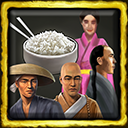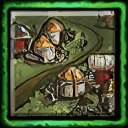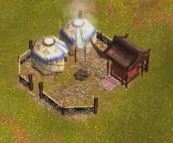Template:Infobox AoE3 Buildings The Village in Age of Empires III: The Asian Dynasties serves as the Chinese counterpart of Houses and Livestock Pens.
Overview
While much more expensive than Houses, Villages provide 20 population (twice than that of the Houses), which can be boosted even further with Chinese Home City cards and improvements at the Village itself. Villages also can serve as Home City drop-off points for shipments, act as Livestock Pens, train Goats and muster defensive units.
Improvements
All of the improvements listed in the table below are available from the Discovery Age.
| Icon | Improvement | Cost | Effect |
|---|---|---|---|
| Town Government | 200 wood | Villages get +10% hit points and provides +5 population | |
| County Government | 200 wood | Villages get +10% hit points and provides +5 population; requires Town Government | |
| Prefecture Government | 200 wood | Villages get +10% hit points and provides +5 population; requires County Government | |
| Provincial Government | 200 wood | Villages get +10% hit points and provides +5 population; requires Prefecture Government | |
| Selective Breeding | 150 wood, 150 coin | Livestock fattens 25% faster |
Home City shipments
As the Village is exclusive to the Chinese, only other civilizations' TEAM cards that affects them are listed here.
| Click for a list of related Home City cards | ||||||||||||||||||||||||||||||||||||||||||||||||||
|---|---|---|---|---|---|---|---|---|---|---|---|---|---|---|---|---|---|---|---|---|---|---|---|---|---|---|---|---|---|---|---|---|---|---|---|---|---|---|---|---|---|---|---|---|---|---|---|---|---|---|
|
Green: TEAM Shipment that is sent to each player in a team EuropeansNative AmericansAsiansChinese
|
History
| “ | During the late fourteenth century, the time of the Ming Dynasty, the Hongwu Emperor began a new policy of distributing vast amounts of land to local farmers. A product of a rural upbringing, the Hongwu Emperor favored farmers, and parsed the land, giving it to young boys who had reached manhood. To prevent the seizure of this land by corrupt landlords, he established non-transferable land titles and did away with taxation. The response was overwhelmingly positive. In 1393, the amount of land being cultivated rose drastically, at speeds never equaled by a later dynasty. | ” |
| “ | Realizing that water conservancy would play a crucial part in the success of Chinese agriculture, the Hongwu Emperor focused on irrigation. He dispatched student from the Kuo-tzu-chien, or Imperial College, to develop massive irrigation systems and develop more than 40,000 ponds and dikes. Because of his decisive actions China experienced an agricultural revolution during the latter half of the fourteenth century. | ” |














